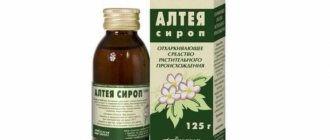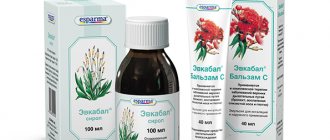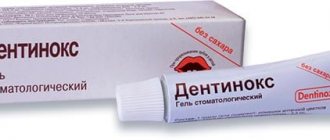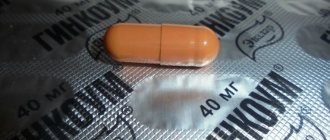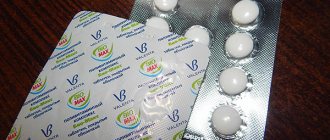Instructions for use FERRUM LEK® syrup
The drug is taken orally during or immediately after meals.
The syrup can be mixed with fruit or vegetable juice in a feeding bottle. To measure the syrup correctly, use a measuring spoon. The appearance of slight coloring of the syrup does not affect the taste and effectiveness of the drug.
The daily dose can be taken at one time or divided into several doses.
The dose of the drug and duration of administration depend on the degree of iron deficiency.
Treatment of iron deficiency anemia (manifest iron deficiency)
continues for 3-5 months until hemoglobin levels normalize. After this, the drug is prescribed for several more weeks to replenish iron reserves in the body.
Adults, nursing mothers, children and adolescents over 12 years of age
As a rule, 10-30 ml (2-6 scoops) of syrup per day is prescribed.
Children aged 1 to 12
years old, 5-10 ml (1-2 scoops) of syrup per day is prescribed.
Children under 1 year of age:
the initial dose is 2.5 ml (1/2 scoop) of syrup. The dose is gradually increased to 5 ml (1 scoop) of syrup per day.
Treatment of latent iron deficiency
lasts for 1-2 months.
Adults, nursing mothers, children and adolescents over 12 years of age:
5-10 ml (1-2 scoops) of syrup per day.
Children aged 1 to 12 years:
2.5-5 ml (1/2-1 scoop) of syrup per day.
Children under 1 year:
Due to the prescription of very low doses, the drug is not used for this indication.
Pregnant women
For the treatment of iron deficiency anemia (manifest iron deficiency) is prescribed
20-30 ml (4-6 scoops) of syrup per day until hemoglobin levels normalize. After this, 10 ml (2 scoops) of syrup per day is prescribed, at least until the end of pregnancy, to replenish iron reserves in the body.
For latent iron deficiency and for the prevention of iron deficiency
Prescribe 5-10 ml (1-2 scoops) of syrup per day.
Daily doses of Ferrum Lek® in the form of syrup for the prevention and treatment of iron deficiency
| Patients | Manifest iron deficiency | Latent iron deficiency | Preventative treatment |
| Children under 1 year | 2.5-5 ml (25-50 mg iron) | —* | —* |
| Children aged 1-12 years | 5-10 ml (50-100 mg iron) | 2.5-5 ml (25-50 mg iron) | —* |
| Children over 12 years old Adults Nursing mothers | 10-30 ml (100-300 mg iron) | 5-10 ml (50-100 mg iron) | —* |
| Pregnant women | 20-30 ml (200-300 mg iron) | 10 ml (100 mg iron) | 5-10 ml (50-100 mg iron) |
* - for this indication, iron supplements are prescribed in very low doses, so Ferrum Lek® syrup is not used.
Ferrum lek syrup 50mg/5ml 100ml No.1
Name
Ferrum lek.
Main active ingredient
Gland
iii
polymaltosate hydroxide.
Release form
Syrup.
Compound
Active ingredient: iron
III
hydroxide in combination with polymaltose. 1 ml of syrup contains 10 mg of iron
III
(as polymaltose iron complex
III
- hydroxide). 5 ml syrup (1 scoop) contains 50 mg iron
III
(as polymaltose iron complex
III
-hydroxide). Excipients: sucrose, sorbitol non-crystallizing solution, methyl parahydroxybenzoate, propyl parahydroxybenzoate, ethanol 96%, creamy essence, sodium hydroxide, purified water.
Description
Transparent brown solution.
Pharmacological properties
Pharmacodynamics
Mechanism of action Polymaltose iron hydroxide complex
III
represents polynuclear iron hydroxide centers surrounded by non-covalently bound polymaltose molecules
III
with a total average molecular weight of about 50 kDa. Multinuclear iron centers
III
hydroxide in complex with polymaltose are similar in structure to the natural iron storage protein ferritin. This macromolecular complex is stable and does not release large amounts of iron under physiological conditions. Due to its large size, the degree of diffusion of iron
III
hydroxide in complex with polymaltose through the mucosal membrane is approximately 40 times lower than the degree of diffusion of the iron hexaaqua complex
II
. Gland
III
hydroxide in combination with polymaltose comes from the intestine through active transport. Iron is used for the synthesis of hemoglobin. Like other iron-based products, Ferrum Lek does not directly affect erythropoiesis or anemia not associated with iron deficiency. Pharmacodynamic effects Absorbed iron binds to transferrin and is used for the synthesis of hemoglobin (Hb) in the bone marrow or is deposited, mainly in the liver, where it binds to ferritin.
Pharmacokinetics
Absorption Iron absorption
III
hydroxide in combination with polymaltose occurs according to a controlled mechanism. The increase in serum iron levels after taking the complex does not correlate with the total absorption of iron, assessed by its inclusion in Hb. Studies using radiolabeled iron
III
hydroxide in combination with polymaltose showed a clear correlation between the percentage of iron absorption by erythrocytes (inclusion in Hb) and absorption in terms of the entire body. The most active absorption of polymaltose iron hydroxide complex
III
occurs in the duodenum and jejunum. As with other oral iron supplements, the relative extent of iron absorption from iron
III
hydroxide in complex with polymaltose, assessed by its inclusion in Hb, decreased with increasing doses of iron. There was also a correlation between the degree of iron deficiency (i.e., serum ferritin level) and the amount of iron absorbed (i.e., the greater the iron deficiency, the better the absorption). When using the drug Ferrum Lek, the degree of absorption is about 10%. It has been shown that in patients with anemia, the absorption of iron from the polymaltose complex of iron hydroxide
III
, unlike iron salts, increases in the presence of food. Bioavailability of iron from iron
III
hydroxide in combination with polymaltose is worse than iron preparations
II
, at least at the beginning of treatment. Distribution Distribution of iron after iron absorption
III
hydroxide complexed with polymaltose was demonstrated in a study using the double isotope technique (55Fe and 59Fe). Biotransformation of Iron
III
hydroxide in combination with polymaltose after absorption is used for the synthesis of hemoglobin (Hb) in the bone marrow or is deposited, mainly in the liver, where it binds to ferritin. Excretion Unabsorbed iron is excreted in the feces. Pharmacokinetics in Special Populations Renal, hepatic and cardiac impairment No data available. Pediatric patients No data available. Elderly patients No data available.
Indications for use
Treatment of latent (hidden) iron deficiency and iron deficiency anemia (clinically pronounced iron deficiency). Iron deficiency and its severity must be established and confirmed by appropriate laboratory tests.
Contraindications
• History of iron hypersensitivity
III
hydroxide in combination with polymaltose or excipients of the drug; • iron overload (for example, hemochromatosis or hemosiderosis) and disorders of iron utilization (anemia associated with lead poisoning, sidero-achrestic anemia, thalassemia); • anemia not associated with iron deficiency (for example, hemolytic anemia or megaloblastic anemia caused by vitamin B12 deficiency).
Use during pregnancy and lactation
Pregnancy To date, there have been no reports of serious adverse reactions when taking Ferrum Lek in recommended therapeutic doses for the treatment of anemia during pregnancy. Animal studies have not shown any risk to mother or fetus. There are no clinical trial data on the use of this drug in the first trimester of pregnancy. In clinical studies of taking the drug Ferrum Lek in the second and third trimesters of pregnancy, no undesirable effects of the drug on the body of the mother and (or) newborns were noted. Thus, the presence of a negative effect of the drug Ferrum Lek on the health of the fetus seems unlikely. Use during pregnancy, however, should be considered with caution. Breastfeeding Breast milk normally contains iron bound to lactoferrin. It is unknown how much iron
III
hydroxide in combination with polymaltose passes into breast milk. It is unlikely that taking Ferrum Lek by nursing women will cause adverse reactions in infants. As a precautionary measure, for women of childbearing age and women during pregnancy or breastfeeding, the use of Ferrum Lek is recommended only after consultation with a doctor to assess the benefit/risk ratio.
Directions for use and doses
For oral administration. The daily dose of the drug depends on the degree of iron deficiency (see table of daily doses). Treatment of iron deficiency anemia in adults and children Duration of treatment: until hemoglobin (Hb) levels are normalized, on average 3-5 months: until hemoglobin is normalized, then for several weeks in doses to treat latent iron deficiency in order to create an iron depot. Treatment of iron deficiency without anemia (latent iron deficiency) Treatment lasts approximately 1-2 months. Table of daily doses Daily dose of iron, in milligrams (mg) Treatment of iron deficiency anemia (overt iron deficiency) Treatment of latent iron deficiency Children under 1 year of age 25-50 mg 15-25 mg Children (1-12 years) 50-100 mg 25 -50 mg Adolescents over 12 years of age and adults 100-300 mg 50-100 mg Iron (mg) in dosage form 25 mg 50 mg 100 mg 200 mg 300 mg Syrup (ml) 2.5 5 10 20 301 Because the dosing cap does not allow accurately dose a single dose below 2.5 ml (25 mg iron), then Ferrum Lek syrup should not be used if the recommended single dose is less than 2.5 ml (25 mg iron). Children under 1 year of age: due to the low dose, treatment of latent iron deficiency with syrup is not possible. Method of administration The daily dose should be taken all at once or divided into several doses. Ferrum Lek should be taken during or immediately after meals. Ferrum Lek syrup can be mixed with fruit or vegetable juices, or with a nutritional formula in a bottle. There may be slight coloration of the mixture, which does not change the taste of the juice/baby food and does not reduce the effectiveness of the drug. If you forget to take Ferrum Lek syrup on time, continue taking the drug as usual. Do not take a double dose to make up for a separate missed dose. Features of use in special groups of patients Renal failure No studies have been conducted in patients with renal failure. No data available. Hepatic impairment No studies have been conducted in patients with hepatic impairment. No data available. Elderly Patients No studies have been conducted in elderly patients. No data available.
Side effect
Safety and Tolerability of Iron Hydroxide
III
in combination with polymaltose was assessed based on a meta-analysis of 24 publications or clinical trial reports, including 1473 patients. The major adverse reactions that were reported in these studies occurred in 4 systemic organ classes. Discoloration of stool is a well-known adverse drug reaction of oral iron supplements (affecting 23% of patients), but is not clinically significant. Other commonly reported side effects were gastrointestinal symptoms (nausea, constipation, diarrhea and abdominal pain). Categories of frequency of adverse reactions are indicated based on the following classification: very often (?1/10), often (?1/100 and
Overdose
In case of iron overdose
III
hydroxide in combination with polymaltose, signs of iron toxicity and overload are unlikely due to the low toxicity of the drug (i.e. in mice or rats: lethal dose, 50% (LD50) > 2000 mg Fe/kg body weight) and controlled absorption of iron. There are no reports of accidental fatal poisonings.
Interaction with other drugs
Iron interaction
III
hydroxide in combination with polymaltose with tetracycline and aluminum hydroxide was studied in 3 clinical studies. There was no significant decrease in tetracycline absorption. The concentration of tetracycline in the blood plasma did not fall below the level providing the required effectiveness. Aluminum hydroxide and tetracycline did not reduce iron absorption
III
hydroxide in combination with polymaltose. Therefore, iron
III
hydroxide in combination with polymaltose can be taken simultaneously with tetracycline or other phenolic substances, as well as aluminum hydroxide. Studies in rats have shown no interactions with tetracycline, aluminum hydroxide, acetylsalicylate, sulfasalazine, calcium carbonate, calcium acetate and calcium phosphate in combination with vitamin D3, bromazepam, magnesium aspartate, D-penicillamine, methyldopa, paracetamol and auranofin . There was also no in vitro interaction observed with food components such as phytic acid, oxalic acid, tannin, sodium alginate, choline and its salts, vitamin A, vitamin D3, vitamin E, soybean oil and soybean flour. These results indicate that the gland
III
hydroxide in combination with polymaltose can be taken with meals or immediately after meals. The drug does not affect the results of the test for the presence of occult blood (selective hemoglobin test), so there is no need to stop treatment for the test. Concomitant parenteral administration and oral administration of iron should be avoided as this significantly reduces the absorption of oral iron.
Precautionary measures
Anemia should always be treated under medical supervision. If there is no effect (hemoglobin level has not increased by approximately 20-30 g/l after 3 weeks), the treatment plan should be reconsidered. Caution should be exercised when prescribing the drug to patients who have received multiple blood transfusions, since red blood cells carry iron, which can cause iron oversaturation. Infections or tumors can cause anemia. Since iron can only be used if the underlying disease is controlled, a benefit/risk assessment is recommended in these situations. During treatment with Ferrum Lek, stool may become dark in color and has no clinical significance. The drug contains sorbitol and sucrose. Patients with rare hereditary disorders such as fructose intolerance, glucose-galactose malabsorption or sucrase-isomaltase deficiency should not take this drug. Sucrose can have a negative effect on tooth enamel. It is expected that taking Ferrum Lek will not affect the insulin administration regimen in patients with diabetes mellitus. One ml of syrup contains 0.04 bread units. This medicinal product contains small amounts of ethanol (alcohol), less than 100 mg per recommended single dose. The drug contains methyl parahydroxybenzoate and propyl parahydroxybenzoate, which may cause allergic reactions (possibly delayed).
Storage conditions
Store out of the reach of children at a temperature not exceeding 25 °C. Store the opened bottle at room temperature.
Buy Ferrum lek syrup 50mg/5ml in bottle. 100ml per pack. No. 1 in pharmacy
Price for Ferrum lek syrup 50mg/5ml in bottle. 100ml per pack. No. 1
Instructions for use for Ferrum Lek syrup 50mg/5ml in bottle. 100ml per pack. No. 1
